There are no products in your shopping cart yet.
K100 Series Filters (2mm)

Loading...








Kase KW100x100 Neutral Night Kit
The Kase Bright Star filter is a Focus Tool designed to help you manually focus on light sources at night. These could be stars or artificial light sources, for example. A series of thin lines etched into the glass surface allow you to focus on a spot of light. Simply place the Night Focus tool in the filter holder and focus manually.
This kit offers the best of both worlds, taking control of the unnatural light and focusing correctly for the best night shots. This means you are assured of a durable product that allows you to capture the most beautiful moments and every detail.
- Kase Wolverine glass with high optical clarity
- Virtually unbreakable
- Nano coatings, which control reflections, repel oil and water, and are mold resistant
- Scratch and shock resistant
- Color neutral
- Dimensions 100x100 mm
- Thickness 2 mm
- 1x KW100x100 mm Wolverine Natural Night filter
- 1x KW100x100mm Bright Star filter
- 2x Storage cover
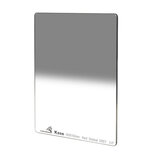
Kase KW100x150 Gradual Hard GND 0.6
GND gray gradient filters have a gradation (gradient) that varies in strength and density across the surface of the glass filter. The filters are often half ND gray filter and the other half is clear. When photographing with long shutter speeds, it is important to be able to control the light. Depending on what you want to block the light from, you can place the gray gradient filter in the correct position. A GND gray gradient filter is often used together with an ND gray filter.
The gray gradient filters have different types of transitions, with different application options.
A soft edge S-GND gray gradient filter is best suited for mountainous, forested or urban environments, where the horizon does not have a flat straight transition.
A medium edge M-GND gray gradient filter can also be used in similar areas to the S-GND, but care must be taken as you need to watch out for dark lines that may appear over trees or buildings.
A hard edge H-GND gray gradient filter is best used in open areas where there is nothing on the horizon, such as coastlines and open plains. With a hard gray gradient filter, the transition from light to dark is clear and fast and is ideal for sea and desert landscapes.
- Kase Wolverine glass with high optical clarity
- Virtually unbreakable
- Nano coatings, which control reflections, repel oil and water, and are mold resistant
- Scratch and shock resistant
- Color neutral
- 0.6 is 2 stops of light reduction
- Thickness 2 mm
- Dimensions 100 x 150 mm
- Hard transition
- Kase Wolverine KW100x150 H-GND0.6 gray gradient filter
- Storage cover
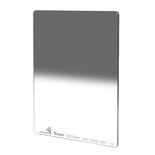
Kase KW100x150 Gradual Hard GND 0.9
GND gray gradient filters have a gradation (gradient) that varies in strength and density across the surface of the glass filter. The filters are often half ND gray filter and the other half is clear. When photographing with long shutter speeds, it is important to be able to control the light. Depending on what you want to block the light from, you can place the gray gradient filter in the correct position. A GND gray gradient filter is often used together with an ND gray filter.
The gray gradient filters have different types of transitions, with different application options.
A soft edge S-GND gray gradient filter is best suited for mountainous, forested or urban environments, where the horizon does not have a flat straight transition.
A medium edge M-GND gray gradient filter can also be used in similar areas to the S-GND, but care must be taken as you need to watch out for dark lines that may appear over trees or buildings.
A hard edge H-GND gray gradient filter is best used in open areas where there is nothing on the horizon, such as coastlines and open plains. With a hard gray gradient filter, the transition from light to dark is clear and fast and is ideal for sea and desert landscapes.
Characteristics
- Kase Wolverine glass with high optical clarity
- Virtually unbreakable
- Nano coatings, which control reflections, repel oil and water, and are mold resistant
- Scratch and shock resistant
- Color neutral
- 0.9 is 3 stops of light reduction
- Thickness 2 mm
- Dimensions 100 x 150 mm
- Hard transition
- Kase Wolverine KW100x150 H-GND0.9 gray gradient filter
- Storage cover

Kase KW100x150 Gradual Soft GND 0.6
GND gray gradient filters have a gradation (gradient) that varies in strength and density across the surface of the glass filter. The filters are often half ND gray filter and the other half is clear. When photographing with long shutter speeds, it is important to be able to control the light. Depending on what you want to block the light from, you can place the gray gradient filter in the correct position. A GND gray gradient filter is often used together with an ND gray filter.
The gray gradient filters have different types of transitions, with different application options.
A soft edge S-GND gray gradient filter is best suited for mountainous, forested or urban environments, where the horizon does not have a flat straight transition.
A medium edge M-GND gray gradient filter can also be used in similar areas to the S-GND, but care must be taken as you need to watch out for dark lines that may appear over trees or buildings.
A hard edge H-GND gray gradient filter is best used in open areas where there is nothing on the horizon, such as coastlines and open plains. With a hard gray gradient filter, the transition from light to dark is clear and fast and is ideal for sea and desert landscapes.
- Kase Wolverine glass with high optical clarity
- Virtually unbreakable
- Nano coatings, which control reflections, repel oil and water, and are mold resistant
- Scratch and shock resistant
- Color neutral
- 0.6 is 2 stops of light reduction
- Thickness 2 mm
- Dimensions 100 x 150 mm
- Soft transition
- Kase Wolverine KW100x150 S-GND 0.6 filter
- Storage cover
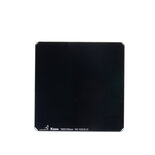
Kase KW100x100 ND1000
ND neutral density filters are used when shooting at slow shutter speeds, to control the exposure time of a scene at the time of capture. The gray filter therefore influences the amount of light that penetrates to the sensor. The extent to which depends on the strength of the ND gray filter used. Gray filters do not affect the colors in your photo, making it easier to work with a longer shutter speed or an open aperture. In addition, Kase filters have precise IR coatings, which provide a true neutral color within a captured image, without the color cast normally associated with slow shutter speed photography.
- Kase Wolverine glass with high optical clarity
- Virtually unbreakable
- Nano coatings, which control reflections, repel oil and water, and are mold resistant
- Color neutral
- Scratch and shock resistant
- Light reduction 10 stops
- Dimensions 100x100 mm
- Thickness 2 mm
- Kase Wolverine KW100x100 ND1000 gray filter
- Storage cover

Kase KW100x100 ND64
ND neutral density filters are used when shooting at slow shutter speeds, to control the exposure time of a scene at the time of capture. The gray filter therefore influences the amount of light that penetrates to the sensor. The extent to which depends on the strength of the ND gray filter used. Gray filters do not affect the colors in your photo, making it easier to work with a longer shutter speed or an open aperture. In addition, Kase filters have precise IR coatings, which provide a true neutral color within a captured image, without the color cast normally associated with slow shutter speed photography.
Characteristics
- Kase Wolverine glass with high optical clarity
- Virtually unbreakable
- Nano coatings, which control reflections, repel oil and water, and are mold resistant
- Color neutral
- Scratch and shock resistant
- Light reduction 6 stops
- Dimensions 100x100 mm
- Thickness 2 mm
- Kase Wolverine KW100x100 ND64 neutral density filter
- Storage cover

Kase KW100x100 ND64000
ND neutral density filters are used when shooting at slow shutter speeds, to control the exposure time of a scene at the time of capture. The gray filter therefore influences the amount of light that penetrates to the sensor. The extent to which depends on the strength of the ND gray filter used. Gray filters do not affect the colors in your photo, making it easier to work with a longer shutter speed or an open aperture. In addition, Kase filters have precise IR coatings, which provide a true neutral color within a captured image, without the color cast normally associated with slow shutter speed photography.
Characteristics
- Kase Wolverine glass with high optical clarity
- Virtually unbreakable
- Nano coatings, which control reflections, repel oil and water, and are mold resistant
- Color neutral
- Scratch and shock resistant
- Light reduction 16 stops
- Dimensions 100x100 mm
- Thickness 2 mm
- Kase Wolverine KW100x100 ND64000 gray filter
- Storage cover

Kase KW100x100 ND8
ND neutral density filters are used when shooting at slow shutter speeds, to control the exposure time of a scene at the time of capture. The gray filter therefore influences the amount of light that penetrates to the sensor. The extent to which depends on the strength of the ND gray filter used. Gray filters do not affect the colors in your photo, making it easier to work with a longer shutter speed or an open aperture. In addition, Kase filters have precise IR coatings, which provide a true neutral color within a captured image, without the color cast normally associated with slow shutter speed photography.
- Kase Wolverine glass with high optical clarity
- Virtually unbreakable
- Nano coatings, which control reflections, repel oil and water, and are mold resistant
- Color neutral
- Scratch and shock resistant
- Light reduction 3 stops
- Dimensions 100x100 mm
- Thickness 2 mm
- The Kase Wolverine KW100x100 ND8 gray filter
- Storage cover

Kase KW100x100 Neutral Night filter
The Kase Wolverine Neutral Night, light pollution filter is a filter, which is used to reduce the impact of artificial light when shooting at night. Near residential areas there is usually light pollution that creates an ugly yellow artificial light in the sky. The Neutral Night filter adds a natural color to the night sky, creating a sharper and clearer image of the stars. The filter is made of high quality Wolverine glass, this ensures, that the filter is almost indestructible.
Features
- Kase Wolverine glass with high optical clarity
- Virtually unbreakable
- Nano coatings, which control reflections, repel oil and water and are mold resistant
- Scratch and shock resistant
- Color neutral
- Dimensions 100x100 mm
- Thickness 2 mm
In the box
- 1x KW100x100 mm Wolverine Neutral Night filter
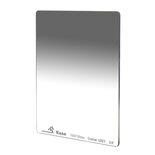
Kase KW100x150 Gradual Soft GND 0.9
GND gray gradient filters have a gradation (gradient) that varies in strength and density across the surface of the glass filter. The filters are often half ND gray filter and the other half is clear. When photographing with long shutter speeds, it is important to be able to control the light. Depending on what you want to block the light from, you can place the gray gradient filter in the correct position. A GND gray gradient filter is often used together with an ND gray filter.
The gray gradient filters have different types of transitions, with different application options.
A soft edge S-GND gray gradient filter is best suited for mountainous, forested or urban environments, where the horizon does not have a flat straight transition.
A medium edge M-GND gray gradient filter can also be used in similar areas to the S-GND, but care must be taken as you need to watch out for dark lines that may appear over trees or buildings.
A hard edge H-GND gray gradient filter is best used in open areas where there is nothing on the horizon, such as coastlines and open plains. With a hard gray gradient filter, the transition from light to dark is clear and fast and is ideal for sea and desert landscapes.
Characteristics
- Kase Wolverine glass with high optical clarity
- Virtually unbreakable
- Nano coatings, which control reflections, repel oil and water, and are mold resistant
- Scratch and shock resistant
- Color neutral
- 0.9 is 3 stops of light reduction
- Thickness 2 mm
- Dimensions 100 x 150 mm
- Soft transition
- Kase Wolverine KW100x150 S-GND0.9 gray gradient filter
- Storage cover

Kase KW100x150 Reverse Gradual R-GND 1.2
R-GND gray gradient filters have a gradient that varies in strength and density across the surface of the glass filter. Half of the filters are clear and the other half is a GND gray gradient filter, which becomes lighter at the top. When photographing with long shutter speeds, it is important to be able to control the light. Depending on what you want to block the light from, you can place the gray gradient filter in the correct position. In a landscape scene the sky is normally brighter than the foreground and at sunrise/sunset a fairly narrow beam of light around the sun is much brighter, so an R-GND filter is placed in front of the lens and moved to a position where the brighter part of the scene is covered by the R-GND filter and the margin between sky and sun, along with the margin between the sun and foreground, are blurred using the transition zones of the R-GND filter. The scene is normally metered for the highlight area and shadow area and the difference in stops dictates the strength of the filter used. Using an R-GND filter avoids the heavy darkening sky normally associated with using stronger GND filters in sunrise/sunset scenes, the transition zones are normally soft.
- Kase Wolverine glass with high optical clarity
- Virtually unbreakable
- Nano coatings, which control reflections, repel oil and water, and are mold resistant
- Scratch and shock resistant
- Color neutral
- 1.2 is 4 stops of light reduction
- Thickness 2 mm
- Dimensions 100 x 150 mm
- Reverse transition
- Kase Wolverine KW100x150 R-GND 1.2 reverse gray gradient filter
- Storage cover

Kase KW100x150 Center Gradual C-GND 1.2
C-GND gray gradient filters have a gradient that varies in strength and density across the surface of the glass filter. The filters are clear and in the middle there is a strip of GND gray gradient filter. When photographing with long shutter speeds, it is important to be able to control the light. Depending on what you want to block the light from, you can place the gray gradient filter in the correct position. At sunrise/sunset a fairly narrow beam of light around the sun is very bright, so a C-GND filter is placed in front of the lens and moved to a position where the brighter part of the scene is covered by the C-GND filter and the margin between light and dark blurred using the transition zones of the C-GND filter. Using a C-GND filter avoids the heavy darkening sky normally associated with using stronger GND filters in sunrise/sunset scenes, the transition zones are normally soft.
- Kase Wolverine glass with high optical clarity
- Virtually unbreakable
- Nano coatings, which control reflections, repel oil and water, and are mold resistant
- Scratch and shock resistant
- Color neutral
- 1.2 is 4 stops of light reduction
- Thickness 2 mm
- Dimensions 100 x 150 mm
- Center transition
- Kase Wolverine KW100x150 C-GND1.2 center gray gradient filter
- Storage cover






Kase KW100x150 Gradual Hard GND 0.75
The gray gradient filters have different types of transitions, with different application options.
A soft edge S-GND gray gradient filter is best suited for mountainous, forested or urban environments, where the horizon does not have a flat straight transition.
A medium edge M-GND gray gradient filter can also be used in similar areas to the S-GND, but care must be taken as you need to watch out for dark lines that may appear over trees or buildings.
A hard edge H-GND gray gradient filter is best used in open areas, where there is nothing on the horizon, such as coastlines and open plains. With a hard gray gradient filter, the transition from light to dark is clear and fast and is ideal for sea and desert landscapes.
Characteristics
- Kase Wolverine glass with high optical clarity
- Virtually unbreakable
- Nano coatings, which control reflections, repel oil and water and are mold resistant
- Scratch and shock resistant
- Color neutral
- 0.75 is just over 2 stops of light reduction
- Thickness 2 mm
- Dimensions 100 x 150 mm
- Hard transition
- Kase Wolverine KW100x150 Gradual Hard GND 0.75 filter
- Storage cover

Kase KW100X150 Gradual Medium GND 0.6
GND gray gradient filters have a gradation (gradient) that varies in strength and density across the surface of the glass filter. The filters are often half ND gray filter and the other half is clear. When photographing with long shutter speeds, it is important to be able to control the light. Depending on what you want to block the light from, you can place the gray gradient filter in the correct position. A GND gray gradient filter is often used together with an ND gray filter.
The gray gradient filters have different types of transitions, with different application options.
A soft edge S-GND gray gradient filter is best suited for mountainous, forested or urban environments, where the horizon does not have a flat straight transition.
A medium edge M-GND gray gradient filter can also be used in similar areas to the S-GND, but care must be taken as you need to watch out for dark lines that may appear over trees or buildings.
A hard edge H-GND gray gradient filter is best used in open areas where there is nothing on the horizon, such as coastlines and open plains. With a hard gray gradient filter, the transition from light to dark is clear and fast and is ideal for sea and desert landscapes.
Characteristics:
- Kase Wolverine glass with high optical clarity
- Virtually unbreakable
- Nano coatings, which control reflections, repel oil and water, and are mold resistant
- Scratch and shock resistant
- Color neutral
- 0.6 is 2 stops of light reduction
- Thickness 2 mm
- Dimensions 100 x 150 mm
- Medium transition
- Kase Wolverine KW100X150 M-GND 0.6 gray gradient filter
- Storage cover

Kase KW100x150 Gradual Medium GND 0.9
GND gray gradient filters have a gradation (gradient) that varies in strength and density across the surface of the glass filter. The filters are often half ND gray filter and the other half is clear. When photographing with long shutter speeds, it is important to be able to control the light. Depending on what you want to block the light from, you can place the gray gradient filter in the correct position. A GND gray gradient filter is often used together with an ND gray filter.
The gray gradient filters have different types of transitions, with different application options.
A soft edge S-GND gray gradient filter is best suited for mountainous, forested or urban environments, where the horizon does not have a flat straight transition.
A medium edge M-GND gray gradient filter can also be used in similar areas to the S-GND, but care must be taken as you need to watch out for dark lines that may appear over trees or buildings.
A hard edge H-GND gray gradient filter is best used in open areas, where there is nothing on the horizon, such as coastlines and open plains. With a hard gray gradient filter, the transition from light to dark is clear and fast and is ideal for sea and desert landscapes.
Characteristics:
- Kase Wolverine glass with high optical clarity
- Virtually unbreakable
- Nano coatings, which control reflections, repel oil and water, and are mold resistant
- Scratch and shock resistant
- Color neutral
- 0.9 is 3 stops of light reduction
- Thickness 2 mm
- Dimensions 100 x 150 mm
- Medium transition
- Kase Wolverine KW100x150 M-GND0.9 gray gradient filter
- Storage cover
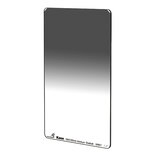
Kase KW100x150 Gradual Medium GND 1.2
GND gray gradient filters have a gradation (gradient) that varies in strength and density across the surface of the glass filter. The filters are often half ND gray filter and the other half is clear. When photographing with long shutter speeds, it is important to be able to control the light. Depending on what you want to block the light from, you can place the gray gradient filter in the correct position. A GND gray gradient filter is often used together with an ND gray filter.
The gray gradient filters have different types of transitions, with different application options.
A soft edge S-GND gray gradient filter is best suited for mountainous, forested or urban environments, where the horizon does not have a flat straight transition.
A medium edge M-GND gray gradient filter can also be used in similar areas to the S-GND, but care must be taken as you need to watch out for dark lines that may appear over trees or buildings.
A hard edge H-GND gray gradient filter is best used in open areas where there is nothing on the horizon, such as coastlines and open plains. With a hard gray gradient filter, the transition from light to dark is clear and fast and is ideal for sea and desert landscapes.
- Kase Wolverine glass with high optical clarity
- Virtually unbreakable
- Nano coatings, which control reflections, repel oil and water, and are mold resistant
- Scratch and shock resistant
- Color neutral
- 1.2 is 4 stops of light reduction
- Thickness 2 mm
- Dimensions 100 x 150 mm
- Medium transition
- Kase Wolverine KW100x150 M-GND1.2 gray gradient filter
- Storage cover

Kase KW100x150 Gradual Soft GND 1.2
GND gray gradient filters have a gradation (gradient) that varies in strength and density across the surface of the glass filter. The filters are often half ND gray filter and the other half is clear. When photographing with long shutter speeds, it is important to be able to control the light. Depending on what you want to block the light from, you can place the gray gradient filter in the correct position. A GND gray gradient filter is often used together with an ND gray filter.
The gray gradient filters have different types of transitions, with different application options.
A soft edge S-GND gray gradient filter is best suited for mountainous, forested or urban environments, where the horizon does not have a flat straight transition.
A medium edge M-GND gray gradient filter can also be used in similar areas to the S-GND, but care must be taken as you need to watch out for dark lines that may appear over trees or buildings.
A hard edge H-GND gray gradient filter is best used in open areas where there is nothing on the horizon, such as coastlines and open plains. With a hard gray gradient filter, the transition from light to dark is clear and fast and is ideal for sea and desert landscapes.
Characteristics
- Kase Wolverine glass with high optical clarity
- Virtually unbreakable
- Nano coatings, which control reflections, repel oil and water, and are mold resistant
- Scratch and shock resistant
- Color neutral
- 1.2 is 4 stops of light reduction
- Thickness 2 mm
- Dimensions 100 x 150 mm
- Soft transition
- Kase Wolverine KW100x150 S-GND1.2 gray gradient filter
- Storage cover

Kase KW100x150 Gradual Soft GND 1.5
GND gray gradient filters have a gradation (gradient) that varies in strength and density across the surface of the glass filter. The filters are often half ND gray filter and the other half is clear. When photographing with long shutter speeds, it is important to be able to control the light. Depending on what you want to block the light from, you can place the gray gradient filter in the correct position. A GND gray gradient filter is often used together with an ND gray filter.
The gray gradient filters have different types of transitions, with different application options.
A soft edge S-GND gray gradient filter is best suited for mountainous, forested or urban environments, where the horizon does not have a flat straight transition.
A medium edge M-GND gray gradient filter can also be used in similar areas to the S-GND, but care must be taken as you need to watch out for dark lines that may appear over trees or buildings.
A hard edge H-GND gray gradient filter is best used in open areas where there is nothing on the horizon, such as coastlines and open plains. With a hard gray gradient filter, the transition from light to dark is clear and fast and is ideal for sea and desert landscapes.
Characteristics:
- Kase Wolverine glass with high optical clarity
- Virtually unbreakable
- Nano coatings, which control reflections, repel oil and water, and are mold resistant
- Scratch and shock resistant
- Color neutral
- 1.5 is 5 stops of light reduction
- Thickness 2 mm
- Dimensions 100 x 150 mm
- Soft transition
- Kase Wolverine KW100x150 S-GND 1.5 gray gradient filter
- Storage cover
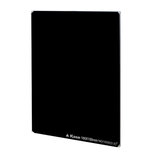
Kase KW100x150 ND1000
ND neutral density filters are used when shooting at slow shutter speeds, to control the exposure time of a scene at the time of capture. The gray filter therefore influences the amount of light that penetrates to the sensor. The extent to which depends on the strength of the ND gray filter used. Gray filters do not affect the colors in your photo, making it easier to work with a longer shutter speed or an open aperture. In addition, Kase filters have precise IR coatings, which provide a true neutral color within a captured image, without the color cast normally associated with slow shutter speed photography.
- Kase Wolverine glass with high optical clarity
- Virtually unbreakable
- Nano coatings, which control reflections, repel oil and water, and are mold resistant
- Color neutral
- Scratch and shock resistant
- Light reduction 10 stops
- Dimensions 100x150 mm
- Thickness 2 mm
- Kase Wolverine KW100x150 ND1000 gray filter
- Storage cover


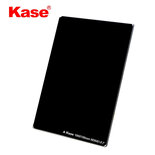

Kase KW100x150 ND64
ND neutral density filters are used when shooting at slow shutter speeds, to control the exposure time of a scene at the time of capture. The gray filter therefore influences the amount of light that penetrates to the sensor. The extent to which depends on the strength of the ND gray filter used. Gray filters do not affect the colors in your photo, making it easier to work with a longer shutter speed or an open aperture. In addition, Kase filters have precise IR coatings, which provide a true neutral color within a captured image, without the color cast normally associated with slow shutter speed photography.
- Kase Wolverine glass with high optical clarity
- Virtually unbreakable
- Nano coatings, which control reflections, repel oil and water, and are mold resistant
- Color neutral
- Scratch and shock resistant
- Light reduction 6 stops
- Dimensions 100x150 mm
- Thickness 2 mm
- Kase Wolverine Kase KW100x150 ND64 gray filter
- Storage cover
